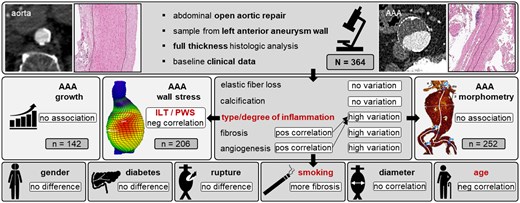-
Views
-
Cite
Cite
Maja Carina Nackenhorst, Felix Menges, Bianca Bohmann, David Zschäpitz, Christine Bollwein, Sven Flemming, Nadja Sachs, Wolf Eilenberg, Christine Brostjan, Christoph Neumayer, Matthias Trenner, Wiebke Ibing, Hubert Schelzig, Christian Reeps, Lars Maegdefessel, Heinz Regele, Markus Udo Wagenhäuser, Claus Jürgen Scholz, Thomas Christian Gasser, Albert Busch, Abdominal aortic aneurysm histomorphology shows different inflammatory aspects among patients and is not associated with classic risk factors—the HistAAA study, Cardiovascular Research, 2025;, cvaf071, https://doi.org/10.1093/cvr/cvaf071
Close - Share Icon Share
Abstract
Abdominal aortic aneurysm (AAA) treatment is upon a diameter threshold. Attempts for medical growth abrogation have failed thus far. This study aims to elucidate the heterogeneity of AAA histomorphology in correlation with individual patient and aneurysm metrics.
Samples from the left anterior aneurysm wall underwent histologic analysis including angiogenesis, calcification, fibrosis, type, and grade of inflammation in adventitia and media. Clinical information and state of aneurysm (intact, symptomatic, ruptured, and inflammatory) were retrieved. Semi-automated geometric analysis (Endosize©, Therenva, Rennes, France) and finite element methods (A4Clinics© Research Edition, Vascops GmbH, Graz, Austria) were included. A total of 364 patients’ samples (85.4% male, median age 69 years) were scored for acute or chronic inflammation, both not associated with rupture (52×), symptomatic disease (37×), or diameter [57 (52–69) mm; P = 0.87]. The degree of fibrosis and the presence of angiogenesis were significantly higher (both P < 0.001) with increasing inflammation, which in turn significantly decreased with patient age (est = −0.015/year, P = 0.017). No significant differences were seen for acute (vs. elective), male (vs. female), or diabetic patients. Aneurysm geometry (n = 252) or annual growth rate (n = 142) were not associated with histologic characteristics. Yet, local luminal thrombus formation was significantly higher with increasing inflammation (P = 0.04).
Type and degree of inflammation are the most distinguishable histologic characteristics in the AAA wall between individual patients, yet are not associated with diameter or rupture. Local luminal thrombus formation is associated with inflammatory features and suggests a vivid bio-physical compartment with intra-individual age-dependent differences.





